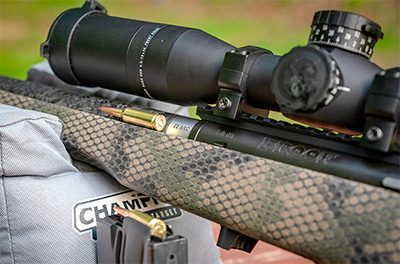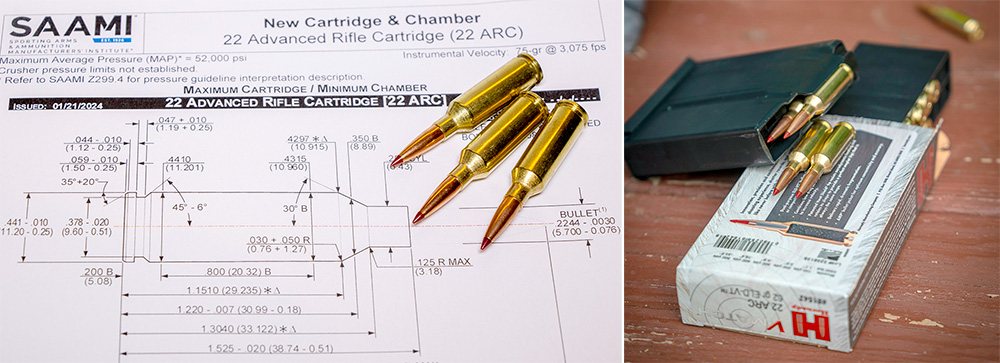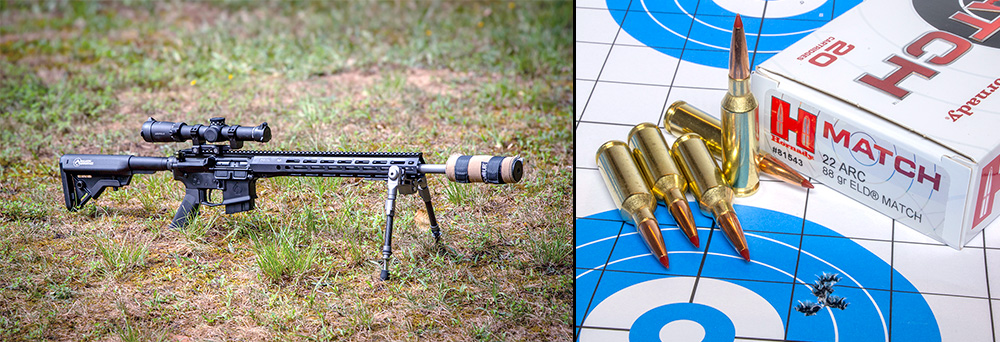Testing 22 ARC
The true appeal of the 22 ARC is in its long-range application, especially out of an AR-15. It will push a bullet to 1,000 yards faster than any other AR-15 cartridge. And, at that distance, the bullet will drop about 7 percent less than its closest competitor, which is the 6 mm ARC cartridge. The 22 ARC also has an advantage when it comes to wind drift. In a 10 mph, 90-degree crosswind, the 22 ARC will drift about 6 percent less than the 6 mm ARC. So, why did it take so long for us to get an AR-15 cartridge that shoots this flat, and where did it come from?
Back to the Future
In 1974 and 1975, Dr. Louis Palmisano and Ferris Pindell—using the 7.62×39 mm/.220 Russian cartridge case—created two wildcat cartridges for benchrest competition. They called them 22 PPC and 6 mm PPC. The cartridges performed well, but never achieved mainstream status. However, while working on a government project a few years ago, a savvy ballistician at Hornady realized this cartridge case had unrealized potential. This led to the 6 mm Advanced Rifle Cartridge (ARC). Then, in January of 2024, Hornady gave us its version of the original Palmisano and Pindell wildcat, and it’s called the 22 ARC.
When it comes to lineage of centerfire cartridges, things can get confusing. When most discuss the 22 ARC and 6 mm ARC cartridges, they reference the 6.5 Grendel as the parent case. But, the 6.5 Grendel is itself based on the 7.62×39 mm cartridge from 1945. In fact, all modern AR-15-compatible cartridges with a .441-inch rim diameter are direct descendants of the 7.62×39 mm. However, by modern standards, the 7.62×39 mm is ballistically uninspiring. So, tethering the lineage of a new cartridge to the ballistically superior 6.5 Grendel is better for business. The 22 ARC is the result of a trip back in time to improve what was a good idea initially imagined a full half-century ago.
22 ARC versus the 22 PPC
Back in the benchrest-competition days of the 1970s, those shooting the 22 PPC cartridge were making their cases from .220 Russian brass. And, since the 22 PPC was never approved by the Sporting Arms and Ammunition Manufacturers Institute (SAAMI), for many years, shooters had to develop their own load data. It wasn’t until 1989, when the 22 PPC-USA was approved by the C.I.P.—the European equivalent of SAAMI—that the 22 PPC received true legitimization. After that, Sako began manufacturing brass and ammunition to the established standard.
All three Hornady 22 ARC loads were evaluated in a Proof Research Elevation 2.0 bolt-action rifle • Extant Hornady factory 22 ARC loads look very similar. You’ll need to be careful not to mix them up, because their ballistic performance is measurably different.
With the 22 ARC—which is technically a modernized version of the 22 PPC—Hornady made three important changes. The first was to minutely alter the case dimensions from those established by C.I.P., and the company also increased the overall cartridge length from 2.19 inches to 2.26 inches. These changes slightly increased case capacity. The next thing Hornady did was drop the maximum average chamber pressure from the C.I.P. specification of 4,050 bar (or about 58,000 psi) to 52,000 psi. Ballistically, neither change made a tremendous difference, but both made this newer version of the 22 PPC fully compatible with the AR-15 platform.
The most important change Hornady made had nothing to do with the cartridge case, and everything to do with the chamber and rifling cut into a barrel. As Hornady has with all of its recent cartridge introductions, it mandated a very fast (1:7-inch) twist rate for the 22 ARC. This is twice as fast as the 1:14-inch rate C.I.P. set for the 22 PPC, and it allows the 22 ARC cartridge to handle longer and more aerodynamic—higher ballistic-coefficient (BC)—bullets. Higher BC bullets mean flatter trajectories and less wind drift. The best performing .223 Rem. loads will drop about 380 inches at 1,000 yards. The 22 ARC drops about the height of a man less than that (roughly 20 percent).
Additionally, Hornady provided handloading data for the 22 ARC, but unusually it provided additional—higher pressure—handloading data for the cartridge for use in modern bolt-action rifles. All factory 22 ARC ammunition will be loaded to 52,000 psi, but with the Hornady bolt-gun load data, you can amp up the cartridge’s performance to 60,000 psi and increase muzzle velocities by as much as 200 fps. (It is vital to note that ammo loaded to 60,000 psi is not safe in AR-15-platform firearms.)
What you might be wondering is, why didn’t Hornady just submit the 22 PPC to SAAMI with updated specifications? Well, that’s exactly what the company did, but it just called it the 22 ARC. You see, if the company asked for SAAMI approval under the 22 PPC name, not only would the new cartridge and ammunition not be incompatible with current 22 PPC rifles, but it would also not have carried the new ARC name and the associated potential for better marketing.
Innovation at the Margins
All this might seem to be a bit disingenuous on Hornady’s part, but the truth is, the 22 ARC is an outstanding—if maybe not completely original—idea. The 22 PPC cartridge and its short, fat case shape with its 30-degree shoulder was an already-proven commodity. It had a great reputation for precision and for minimal case stretching, which is something handloaders like. There was no reason for Hornady to “reinvent the wheel;” you could say it just made it better so it would be more compatible with the most popular rifle platform in America.
Beyond that, Hornady also brings an array of extremely high BC, .224-caliber bullets. This is in line with what the company has done with all of its recent cartridge innovations in other calibers. The 22 ARC leverages the benefit of a faster twist rate, as do the 6.5 Creedmoor, 6.5 PRC, 7 mm PRC, 300 PRC and 6 mm ARC. Custom rifles in similar calibers with fast-twist barrels exist, but the availability of factory ammunition for the Hornady cartridges sets them apart.

Testing the 22 ARC
That’s a lot of history and technical information just to get to what should matter most, and that’s what kind of performance you can expect from the 22 ARC with Hornady ammunition. Hornady is currently the only major manufacturer offering 22 ARC ammunition, and it currently sells three loads. I evaluated all of those loads in both an AR-15 and a bolt-action rifle.

The 22 ARC is now a SAAMI-approved cartridge that is in essence an improved/modified version of the 22 PPC.
The AR was like many some of you could put together using a new barrel and components you might have on hand. I used a Ballistic Advantage upper receiver with an 18-inch barrel ($559), a Ballistic Advantage Breach Charging Handle ($79) and a Ballistic Advantage enhanced lower receiver with a B5 Systems B5 stock ($287.99). I added a Timney Impact trigger ($134.99) and used the bolt-carrier group from my Stag Arms Stag 15 in 6.5 Grendel. The bolt gun was a factory-stock Proof Research Elevation 2.0 with a 20-inch carbon-fiber-wrapped barrel ($3,499).
I evaluated all three loads in each rifle by firing five, five-shot groups from a sandbag rest at 100 yards. I did all the shooting with a Banish Backcountry suppressor from Silencer Central. The first 10 shots with each load from each rifle were chronographed to establish average velocity information. Afterward, I conducted some longer-range shooting out to 300 yards—mostly for fun and to get an idea of trajectory and reliability.

Hornady’s 22 ARC cartridge was approved by SAAMI with a 52,000 psi maximum average chamber pressure • While the SAAMI-approved specifications for the 22 ARC specify a maximum overall length (OAL) of 2.6 inches, in some bolt-action rifles, handloaders will be able to increase this OAL due to greater magazine lengths in those platforms.
The Hornady ammunition was quite consistent. The overall average for both rifles for all groups fired was 1.01-inch. The bolt gun shot a bit better, but the home-built AR-15 didn’t do bad at all. In fact, the more I shot the AR-15, the better it performed; my last groups with each load were the smallest fired. Function wise, there were no issues with the bolt rifle, which fed from an MDT AICS magazine. There was one failure to fully chamber with the AR-15, and when I cleared the stoppage, I found a tip from the 88-grain ELD Match bullet had come off and interfered with bolt lock up.
Except for the 62-grain load, velocities out of the 20-inch-barreled Proof Research rifle were similar to advertised velocities. The 62-grain load was 87 fps, or about 2.6 percent, slower than advertised. On average, velocities from the 18-inch barreled AR-15 were 123 fps, or about 4 percent, slower than those from the bolt gun. But, all three loads in both rifles delivered very consistent velocities with standard deviations less than 20 fps.

The author also tested current 22 ARC offerings in a home-built AR-15 made primarily from Ballistic Advantage components • Out of the bolt-action Proof Research Elevation 2.0 rifle, the overall average for five shot groups with all three 22 ARC loads was a respectable .86 inch.
Good Idea or Bad?
By riding the coattails of two enterprising benchrest shooters from a half-century ago, Hornady has given us a fantastic new cartridge. Though it will never be more popular or practical than the .223 Rem. in the AR-15, the 22 ARC does offer substantially better reach for the long-range practitioner. With it comes more expensive ammunition and reduced magazine capacity, but for those who enjoy playing or competing at distance, neither are that important.
Like with all new cartridges, there will be those who poo-poo the 22 ARC’s existence. They’ll claim it solves no problems or does not provide a substantial advantage. The truth is it does both; it’s the flattest-shooting, SAAMI-approved AR-15 cartridge in existence. This means those folks who attack either don’t see (or willfully ignore) the advantages or suffer from neophobia. What so many naysayers tend to overlook is that everything with guns and ammunition is not always about practicality or massively substantial ballistic improvements. Guns are fun to shoot, and new guns and cartridges are fun to experiment with. After all, the primary reason most of us do any shooting at all is to have fun, and you can have a lot of fun with the new 22 ARC.
Read the full article here


